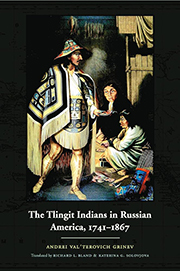November is Native American Heritage Month – a perfect time to honor Indigenous traditions, cultures, and histories. At UVA Library, we’re highlighting work created by and about Native Americans.
Thanks to Librarian for History and Religious Studies Keith Weimer, and Curator of Material Culture Meg Kennedy for the book recommendations below.
 “The Tlingit Indians in Russian America” by Andrei Valterovich Grinev (University of Nebraska Press, 2005)
“The Tlingit Indians in Russian America” by Andrei Valterovich Grinev (University of Nebraska Press, 2005)
Totem poles are iconic symbols of Native American life, but the people of the Pacific Northwest who created them rarely feature in popular depictions or even scholarly histories of Native Americans. Andrei Grinev helps fill this gap. A powerful tribe with a complex society, the Tlingit halted Russian expansion into the Pacific Northwest. The Russians never dominated the Tlingit, who took advantage of British and American trading networks to expand their influence in the region, assimilating some neighboring peoples. Some Tlingit eventually visited St. Petersburg and other cities of European Russia. However, smallpox epidemics devastated the tribe, and there were occasional armed conflicts. Grinev describes Tlingit culture and spirituality and illustrates the great ethnic diversity of participants in the Pacific Northwest trade. His depiction of other Indigenous peoples like the Aleuts reflects a sense of Tlingit superiority, however.
— Keith Weimer
 “Cahokia: Ancient America’s Great City on the Mississippi” by Timothy Pauketat (Viking, 2009)
“Cahokia: Ancient America’s Great City on the Mississippi” by Timothy Pauketat (Viking, 2009)
Indigenous Americans created a great city on the Mississippi River across from modern St. Louis between 1050 and 1400 CE, with temple mounds higher than those in Mexico and a population approximating that of London during the same period. Archaeologist Pauketat speculates that the rapid growth of Cahokia was spurred by the appearance of a supernova in 1054 that many indigenous Americans interpreted as the arrival of a messianic figure, “the Morning Star,” whose reign would be centered around this existing trading hub. He notes difficulties in knowing which modern indigenous people can claim direct links to this civilization. Siouan tribes like the Osage and Omaha displayed the strongest cultural similarities to discoveries at Cahokia, but parallels can be traced among the Iroquois, the Cherokee, and other groups. Discoveries at Cahokia also suggest contact with Mexico. Pauketat admits to gaps in our knowledge of this period, but his book serves as a good introduction.
— Keith Weimer
 “The Rediscovery of America: Native Peoples and the Unmaking of U.S. History” by Ned Blackhawk (Yale University Press, 2023)
“The Rediscovery of America: Native Peoples and the Unmaking of U.S. History” by Ned Blackhawk (Yale University Press, 2023)
In a new expansive continental history spanning centuries, Ned Blackhawk places Indigenous people at the center of the “American” story. He uses case studies, including some well-known to American school children, to create what he calls a “reorientation of U.S. history.” Blackhawk applies a multiracial framework to shed light on the varied and shared experiences of the more than 75 million Native people living in the Americas in 1492 and their descendants. In an early chapter, he explores the more than one million Native Americans who were enslaved and trafficked during the 16th and 17th centuries, which Blackwater parallels to stories of displacement, disease and warfare that uprooted entire communities at the times of European colonization. Other chapters focus on the sophisticated urban complexity of Tenochtitlan, the robust cross-cultural trade afforded by the visitor accommodations at Mandan settlements along the Missouri River and the roles of many tribal nations in the creation of American statehood. “The Rediscovery of America” continues through to the 20th century, emphasizing activism, sovereignty initiatives, the tragedies of Native boarding schools, and the conclusion of separation policies in the 1950s, reorienting the reader along the way.
— Meg Kennedy
